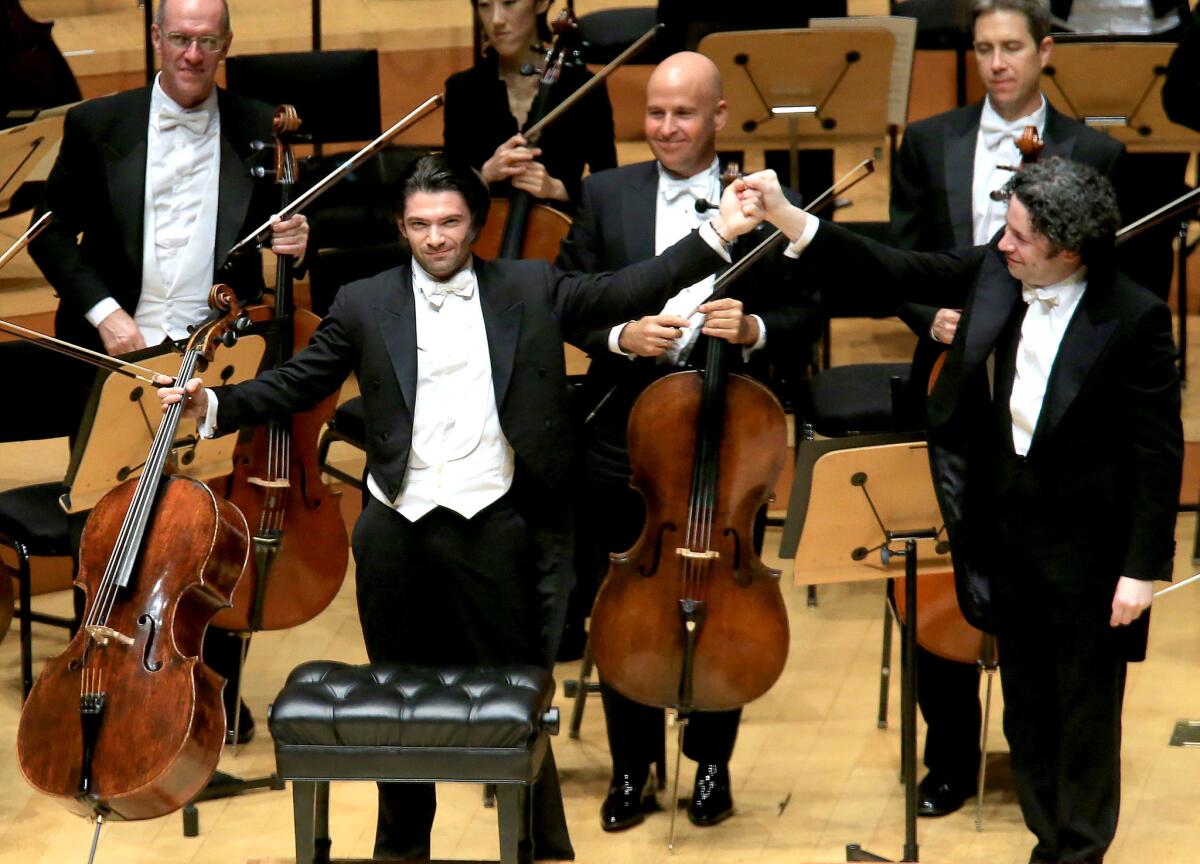Review: Max Reger a crowd pleaser at a full and festive Disney Hall

- Share via
To what extent traffic affects attendance at Walt Disney Concert Hall is hard to know. Anecdotal evidence suggests that commute time matters. Even Los Angeles Philharmonic concerts conducted by Esa-Pekka Salonen and Gustavo Dudamel last month — when record numbers of cars seemed to jam freeways — were not, as they usually were in the past, full.
On Friday night, the roads were all but empty; Disney was full and festive. Some of the attendance may have been thanks to tourists. Dudamel was conducting, and he remains, of course, a draw. But the brilliant soloist, French cellist Gautier Capucon, is not yet as widely famous as he deserves to be.
Worse, far worse, the program began with Max Reger, a composer considered a deal breaker on the U.S. concert scene. The gloomy, late Romantic German’s foggy, dense harmonies and tightly knotted counterpoint may have a history of a certain regard in German-speaking regions. When Rudolf Serkin, however, insisted on playing Reger’s 40-minute piano concerto elsewhere, the work became known as “Serkin’s folly.”
My guess is that most in the crowd, and especially those in town for the holiday and drawn to a famous concert hall and conductor, arrived with unprejudiced ears. Friday’s persuasive performance of “Four Tone Poems After Arnold Bocklin,” which began the program, proved the crowd pleaser it deserves to be. There was scattered applause after each short movement and a partial standing ovation at the end.
Reger might seem a reactionary. The “Bocklin” pieces were written in 1913, the revolutionary year of Stravinsky’s “Rite of Spring” and Schoenberg’s “Pierrot Lunaire.” The composer, who would live only until 1916, was 40 and haunted by Wagner and Bach. But Reger was driven not so much by nostalgia as by a vision of an alternate universe in which the Old World might survive through a willful combination of dreaminess and complex thought.
His response to Bocklin’s paintings was mystical and stands in interesting contrast to the musical world around him. The first, “Hermit Fiddler,” features an ethereal violin solo that anticipates by a year Vaughan Williams’ popular and similar sounding 1914 “The Lark Ascending.” On the other hand, Debussy was playing in the waves in “La Mer” a few years before Reger’s “In the Play of the Waves,” the second of the Bocklin tone poems. Debussy’s sea sought a new route to Asia, whereas Reger pursued the flamboyant realm of mythical creatures.
In “The Isle of the Dead,” Reger used the orchestra as though it were an organ. Long-held but shifting sonorities here suggest a barcarole as a voyage to the underworld. Rachmaninoff’s more famous tone poem on the same painting, written in 1908 and on Dudamel’s program this week, is more conventionally melodramatic.
The final painting, “Bacchanal,” provides an interesting challenge for a conductor. Is this a rigid Reger revealing the folly of earlier orgiastic times or an admiring composer wanting to vicariously join in? Dudamel gave him the unstuffy benefit of the doubt and let rip.
Elsewhere, Dudamel emphasized color and atmosphere. He did not convey an unsuspected radicalism in Reger, but he did produce a tonal nuance, and the strings, winds and brass were able to evoke the glowing use of oils on canvas. Concertmaster Martin Chalifour was the radiant violin soloist.
The remainder of the program was a glimpse, after Reger, at long-gone, less complicated times. Capucon was, in every way, ravishing in Haydn’s upbeat, youthful Cello Concerto in C Major. Dudamel ended the evening with Schubert’s Sixth Symphony, also youthful, upbeat and in C Major.
Both of these were works by composers in their 20s. The Haydn has excellent tunes, including a sublime slow movement, but doesn’t seem to be the greatest challenge for a cellist until someone like Capucon plays it as though a chef with the remarkable flair to bring out hidden flavors in ingredients that might otherwise seem ordinary.
Schubert’s symphony is that of a 21-year-old with a musical personality fully formed but not yet a vision. He follows, in many places, Beethoven’s example, but without the brashness.
In the Haydn, Dudamel kept the orchestra small. Timpanist Joseph Pereira used small period drums for a lighter effect. Effervescence was achieved.
Dudamel’s Schubert also acknowledged a time when orchestras were small and less heavy sounding than modern bands. There was plenty of instrumental padding. Schubert played off the different sonorities of winds and strings while at the same time creating unbroken lyrical phrases.
Dudamel’s main effort was on really long lines. He relied on quick tempos to help. He smoothed rough edges while at the same time emphasizing exciting propulsion. The result was an early 19th century study in shifting textures not dissimilar to what Reger would do a century later or what Los Angeles automobiles would achieve another century later on a Black Friday evening rush hour.
More to Read
The biggest entertainment stories
Get our big stories about Hollywood, film, television, music, arts, culture and more right in your inbox as soon as they publish.
You may occasionally receive promotional content from the Los Angeles Times.











